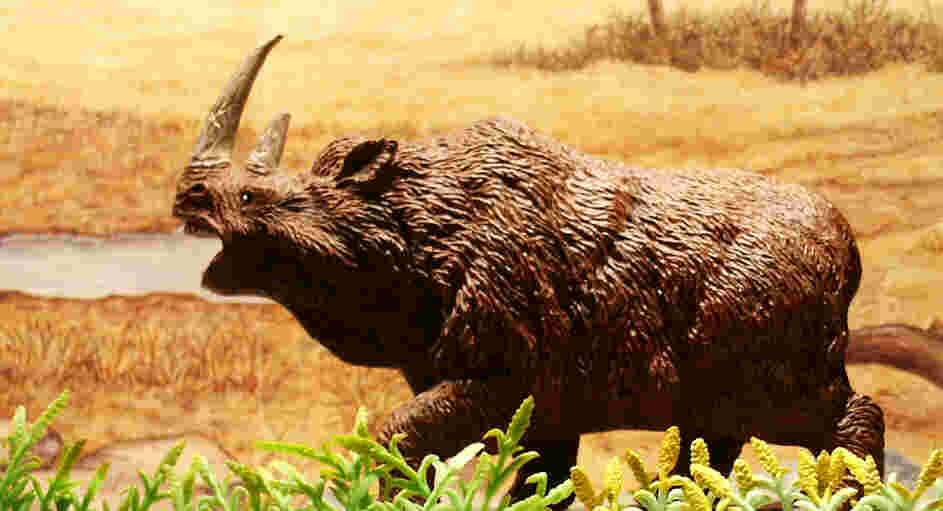
Dinosaur Collector presents the Pleistocene Ice Age 70,000 years ago of Europe, Asia and North America supported animals known as the Pleistocene Megafauna. While the Wooly Mammoth is the best known, the Ice Age grasslands supported two rhinoceros, two horned Coelodonta and single horned Elasmotherium. There were also giant bison, musk oxen, horses, caribou, bears and antelope adapted to this environment. Most of these giants died out at the end of the ice age. The result of the disappearance of the grasslands and predation from early man. Updated 9/15/08
more
COELODONTA antiquitatis was a huge beast that lived in
during the last ice age. The Coelodonta had a massive body and a thick, shaggy
coat that protected it against the harsh climate of the tundra and steppe that
bordered the great glaciers of the Northern Hemisphere. Coelodonta had a pair of
huge horns on its snout that reached lengths of up to 3ft in the largest of
males. These creatures were hunted by early humans and they were depicted on the
walls of caves in France 30,000 years ago.
Safari Missing Links Wooly Rhinoceros
While the Wooly Mammoth ranged through Europe, Asia and North America, Coelodonta the Wooly Rhinoceros never made it to North America. Well-preserved Wooly rhino remains were found frozen in ice in the Ukraine. A complete female carcass was found buried in the mud. The combination of oil and salt prevented the remains from decomposing allowing the soft tissues to remain virtually intact. This specimen is currently mounted in the Paleontology Museum in Krakow, Poland. A study of horse bones from the prehistoric steppes of Interior Alaska found that the horses shrank in size over a few thousand years, then the species disappeared from the region about 12,500 years ago before the first evidence of man. This is best explained as a change in environment from the dry grassland of the Ice age to the wet tundra of today.
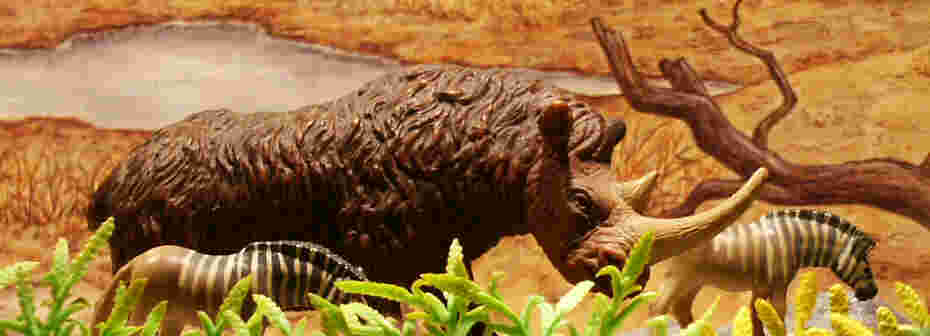 .
.
Bullyland Wooly Rhinoceros. The Quagga a recently extinct mammal, closely related to zebras is from a series of extinct and endangered animals.
Megaceros giganteus ("gigantic large horn"), is the prehistoric Irish elk (more closely related to the fallow deer than the elk). It was the biggest deer that ever lived; it was over 10 feet (3 m) tall and had enormous antlers 11 feet (3.3 m) across (the largest of any deer). These antlers were shed yearly. Megaceros dates from the late Pleistocene (from 1.5 million to 2,500 years ago). Large herds lived in what is now Europe and western Asia. It was preyed upon by giant cats and wolves and it was hunted by early humans.
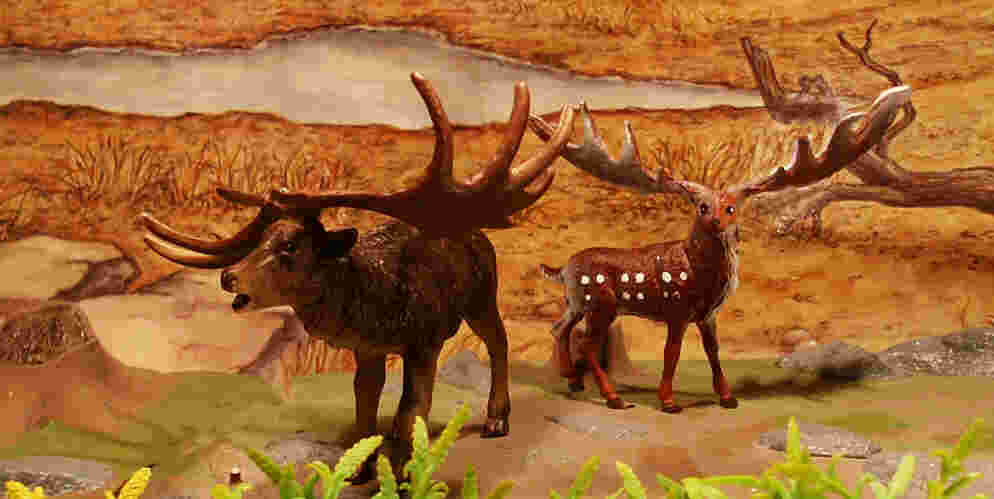
Bullyland and Starlux Irish Elk.
Smilodon the larger and better known saber toothed cat and preferred the warmer climes. Homotherium ranged far to the north and was adapted to the cold conditions of the mammoth steppe environment. Homotherium has a very hyena-like appearance, because of the exceptionally long front limbs that cause the back to slope towards the rump. Finds at Friesenhahn cave in Texas of many remains of Homotherium individuals of all ages associated with the milk teeth of more than seventy baby mammoths hint at a specialized hunting strategy. Equus lambei is a donkey sized horse that lived in North America during the last Ice Age. It disappeared at the end of the Pleistocene when the climate warmed up and the grasslands declined.
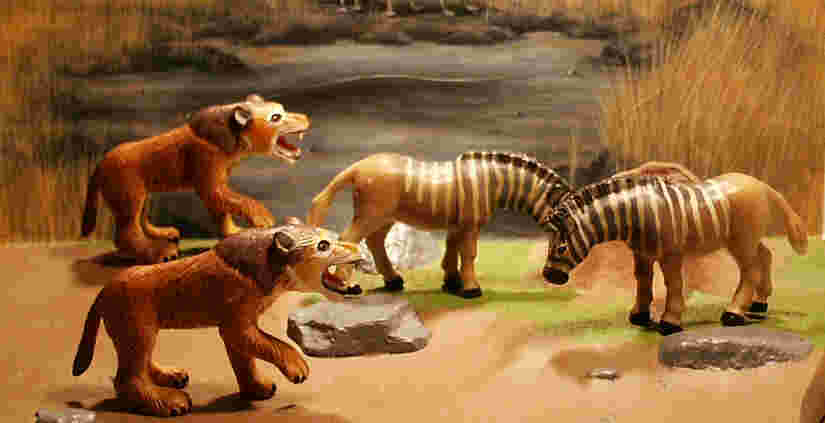
Play Vision Saber toothed cat from small mammals series based on the The Simon and Schuster Encyclopedia of Dinosaurs and Prehistoric Creatures. The Quagga a recently extinct mammal, closely related to zebras is from a series of extinct and endangered animals sold by Friends of the Earth.
Since Wooly Rhinos were hunted by early humans and they were depicted on the walls of caves in France we have some idea of their coloring and appearance. Wooly Rhino lived just as his recent relatives do, alone or in very small family groups. The horn is made of modified hair and is not a part of the skull. The closest living relative to the Wooly Rhino is the Sumatran rhinoceros this is based on recent DNA work.
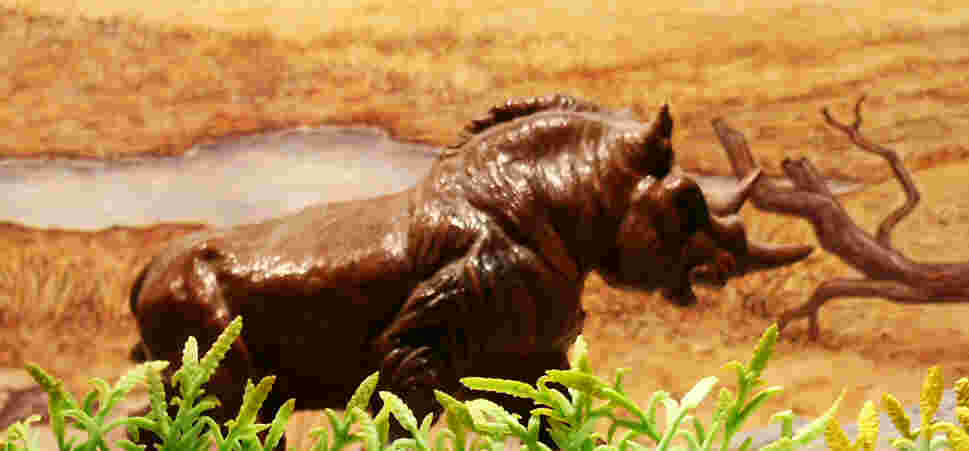
Miller Wooly Rhino from the large series.
The best known men from this time come from Western Europe. We know a great deal about what animals looked like from the cave art left begin by the Cro-Magnon people.
Bullyland caveman from the Evolution of Man series. Cave painting original art work by Taliesin Knol.
Return to Tertiary Menu
 Site A icon to the right for Dioramas organized by period or by manufacturer.
Site A icon to the right for Dioramas organized by period or by manufacturer.